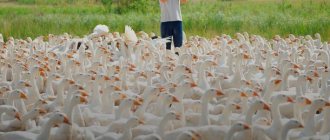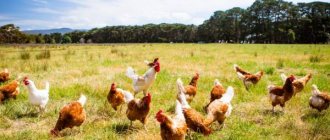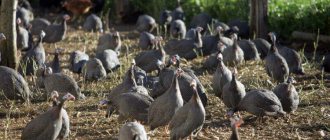- home
- Business ideas
Nadezhda Klimenko
0
Article navigation
- Relevance of the idea of sheep farming
- Where to start a sheep farming business?
- Choosing a format
- Sheep farming: advantages, technology
- Development of breeding sheep breeding
- Drawing up a business plan: what is it for?
- Market and industry analysis
- Organizational part
- Registration
- Search and rent land for farm and pasture
- Finding personnel to work on the farm
- Selecting and purchasing animals
- Where to buy sheep and rams?
- Marketing part
- Receipt and sale of products
- Finance
- Basic expenses when organizing a sheep farm
- Revenue part
- Profitability of sheep breeding
- Results
Sheep farming in Russia flourishes mainly in the Caucasus and some southern regions. But it can also be done by those who live in the middle zone. Today we will talk about where to start a sheep farming business, how to make it as profitable as possible and what risks to take into account.
Relevance of the niche
In livestock farming, the business of sheep breeding is relevant. They are less susceptible to diseases, which is a favorable factor for this industry. In Russia this direction is quite promising.
Let's consider the advantages of sheep farming as a direction in livestock farming:
- Opportunity to receive government support for agricultural development;
- Small start-up investment;
- Low feed costs;
- High demand for lamb with low competition;
- Year-round production;
- Minimum requirements for conditions of detention;
- Rapid maturation and livestock growth;
- Easy process.
As you can see, this business is very profitable for the entrepreneur, since the rapid increase in livestock fully justifies the costs and generates income in the shortest possible time.
But there is one significant drawback that should be mentioned. This is a low profitability, which is about 15 - 20 percent. It is also necessary to keep in mind that the first income will have to be reinvested into improving the sheep herd. In order to ensure a steadily growing and reliable business.
However, the demand for sheep products (meat, wool, milk) is constantly growing and, according to statistics, amounts to 2 - 2.5 tons.
Thus, we see three components of the success of sheep farming as a business - these are minor start-up investments, consistently high demand, and minimal requirements for living conditions. Therefore, this type of activity is an ideal option for farming.
Where to start a sheep farming business?
The precocity of this cattle is an undeniable advantage for businessmen. At the age of 5-6 months, sexual maturity occurs, which makes it possible to effectively breed livestock.
Choosing a breed is the most important step
Fertility depends on the breed. On average, it is 120-140%; some breeds, such as Romanov sheep, are distinguished by a high degree of fertility - about 300%. At the same time, the young animals reach the full weight of an adult by the 10th month of life. The increase per day is about 300 grams.
Those who have decided to enter such a business are interested in where to start raising sheep?
First of all, it is necessary to draw up a competent business plan that will allow you to correctly calculate costs and draw up a phased implementation of all parts of production.
For breeding, it is necessary to organize a pasture, the size of which will depend on the livestock. It is advisable to immediately focus on the future and choose a pasture with the possibility of expanding the livestock.
Calculating the size of the pasture
To calculate correctly, focus on average indicators: 1 hectare of land is needed for 1 individual and raising offspring. With simple calculations we get the following figures: to raise 200 sheep you will need about 200 hectares of land. As for the premises in which livestock will be kept, there are no clear requirements, so it will be enough to build a simple barn that shelters the animals from precipitation, wind and cold.
For those who raise livestock in the eastern and northern parts of the country, it is necessary to consider a barn heating system. However, a small potbelly stove will be enough for a farm.
Prices for the range of solid fuel boilers
Solid fuel boilers
Heating the sheepfold
The most favorable regions for this industry are the Krasnodar and Stavropol Territories. The Republic of Kalmykia and the Caucasus are not inferior in popularity to keeping sheep dogs. For sheep farming in other areas, obtaining feed can be a serious problem. The efficiency of this business largely depends on the quality of the feed. It will not be possible to feed livestock with grass alone, especially when it comes to northern latitudes. It will be necessary to purchase feed, which will affect costs and greatly affect profitability.
In order to implement entrepreneurial activity in this direction, it is first necessary to find appropriate pasture. This will be the first step in farming.
To minimize costs, you can use an existing empty farm as a basis. Today you can find hundreds of similar objects in which dilapidated stalls and pens remain.
Of course, organizing a farm with this option will require significant effort, but it is much easier than starting from scratch.
An abandoned farm is suitable for budding businessmen
Choosing a format
When starting to engage in this type of business, it is important to immediately determine the format for yourself. It can be of two types: farming or private farming. What is the difference between them and how to choose the best option?
Farming
The conditions of business processes are regulated by legislative standards. Private subsidiary farming is recognized by law as a non-entrepreneurial form. That is, the owner of such a farm raises livestock to meet his own needs and on his personal land plot.
Farming involves leasing a plot of land and raising livestock for business purposes. In order to choose your option, you need to clearly understand the distinctive features of these two types of activities.
When setting up his own personal subsidiary plot, the owner does not need to register business activities and obtain a Certificate. Having a plot of land at your disposal, you can begin to create a sheepfold. In this case, there is no need to submit reports to tax authorities and extra-budgetary funds.
Pasture
But this type of activity has a serious limitation - the plot of land is up to 2.5 hectares. That is, if the land owner plans to breed larger amounts of livestock, then it is necessary to switch to the second option.
To implement a farm, it is necessary to register an individual entrepreneur, issue a land lease and the appropriate permit that allows you to operate on this land.
The area of land is not limited by law when farming. Another advantage of farming is the opportunity for the entrepreneur to participate in various government grants and programs that are aimed at developing the agricultural industry.
State programs for the development of livestock farming
Such assistance from the state is not provided to private businesses.
Therefore, if an entrepreneur does not have initial investments, then it is better to pay attention to farming activities. This is a more serious object of economic relations, which has the opportunity to participate in various subsidy programs.
About business
When drawing up a business plan for sheep breeding, it is necessary to take into account issues related to production technology.
First of all, it is necessary to create conditions for walking the livestock and think over their diet. Sheep are unpretentious in terms of food and maintenance, so this should not be a problem.
Sheep are not fed by the clock, so they must have constant access to feed. The pen must have feeders with food and drinkers with water.
Pieces of rock salt are added to the feeders to aid the sheep's digestion. In summer, if there are good pastures, fertilizing is not required. And in autumn and winter, animals are fed grains - barley, oats and hay.
It is worth thoroughly preparing for winter. It is necessary to calculate the amount of necessary fertilizing and prepare mowed grass in advance so that it is the main component in the diet of the livestock.
The most suitable grasses for feeding sheep are clover and bluegrass.
If you plan to harvest and sell wool, then it is worth diversifying your diet with vitamin supplements. Despite the fact that expenses will increase, income from the sale of high-quality wool will not only cover them, but will also bring profit.
One sheep needs per year:
- 1.5 centners of hay;
- 1 quintal of straw;
- 1 quintal of concentrate or grain;
- 2.5 quintals of green grass.
To find out the amount of your costs for feeding all the sheep, you need to multiply these figures by the number of available individuals.
We need constant monitoring of the conditions of detention - the availability of water and food. It is important to maintain a comfortable temperature and not allow the room to overheat. This is fraught with diseases and the appearance of parasites.
Drawing up a business plan: what is it for?
The implementation of any entrepreneurial activity is preceded by the stage of drawing up a business plan. Many novice businessmen lose sight of this point and immediately begin implementing the project. At the same time, the lack of a clear plan, calculation of payback, profitability, or analysis of the competitive environment puts the entire business at risk.
A good plan is the key to success
Why is it necessary to write a business plan, and what issues should it cover first? The document helps you realistically assess your capabilities as an entrepreneur, correctly predict expenses and income, and minimize financial risks.
A business plan is a desktop guide for an entrepreneur and a valuable guide for launching and developing a project.
The standard document consists of the following sections:
- Summary (relevance of the idea).
- General provisions.
- Environmental analysis (competition level, market demand).
- Description of activity.
- Marketing section (formation and search of product sales channels).
- Organizational (recruitment, premises, equipment purchase, etc.).
- Financial (forecast of expenses, income, calculation of profitability).
All these points need to be worked out regardless of the format of activity and production volumes. Beginning farmers unfamiliar with this industry are better off seeking help from professionals in developing a plan, analyzing the environment, and selecting a breed.
Market analysis
At the moment, a suitable period has emerged for the implementation of the idea of breeding sheep as a business.
There is little competition in this niche. Which leads to a reduction in financial risks and to a pricing policy aimed at maximizing the entrepreneur’s profit.
The trend towards a reduction in the number of sheep was a consequence of high demand for products and low competition.
Statistics on the number of sheep in private farms indicate that business in this direction is promising. According to the numbers, this is approximately 10 million individuals. Due to their territorial location, not all regions of Russia are suitable for this type of business. The southern and central regions are considered acceptable for this.
These are the Caucasus, Stavropol and Krasnodar territories, the Southern Urals and the Volga region. The listed areas are provided with the most fertile areas for walking animals.
Different breeds of sheep adapt differently to different climates and natural conditions. The most suitable for meat and fat breeds are regions with cold climates and mountains. For coarse-haired dogs - the North Caucasus, for fine-haired dogs - the Central regions. The best climate for raising sheep is in the Caucasus, where the largest number of farms and pastures are found.
Legal Features
Breeding sheep at home with the subsequent sale of finished products will require registering your own enterprise. If you plan to open a small company, then you should abandon the idea of creating an LLC. It is better to choose one of the following forms:
- IP;
- Peasant farm.
The opening of a peasant farm will require the signing of an Agreement on the establishment of a farm. This is necessary to notify the registration authority. The OKVED code should be 01.22.1 – “Sheep and goat breeding”. This category includes not only the breeding of breeding animals, but also the production of milk, wool, and fluff. Before opening, you will have to take care of obtaining permission from the SES.
Business registration
If you decide to breed sheep and build a business on it, then the question of registering it arises. As a rule, the owner needs constant distribution channels, which require documentary evidence of transactions. Therefore, it is necessary to register an individual entrepreneur.
In addition, you will need to obtain permission from the sanitary and epidemiological inspection to work with wholesale clients.
Permission from the fire department is required to confirm that the sheepfold meets all technical requirements.
If you want to save time and nerves, you can resort to the help of specialists. Then the purchase of such services is reflected in expenses.
Pasture and sheepfold
The first thing you should think about is purchasing pasture. The territory for it can be bought or rented. In general, there can be many options, for example, a bankrupt collective farm and abandoned buildings, territories, paddocks. Study the situation in the nearby area, maybe you can find a suitable option.
As for the sheepfold, there is no need to build a permanent structure with heating - sheep can easily tolerate low temperatures.
Land for business
After all the documents have been completed, a pasture suitable for raising sheep is found.
Many people are considering buying their own land. But the optimal solution for starting sheep breeding is to rent a plot of land. This is a less expensive option with no financial risks.
Sheep easily get used to weather conditions, so in summer it is advisable to use walking in open areas, and in winter - in pens, with small heating units.
Financial side of the issue
Let's assume that we create a farm with a livestock of 300 animals. Where did this figure come from? Everything is very simple - to obtain a high yield of meat, a minimum of three hundred animals is required. If you take less, you will most likely end up with an individual farm that will not be able to bring in a really serious income.
So, these 300 heads will cost us approximately 1 million 350 thousand rubles, subject to the purchase of animals at the minimum wholesale price (4.5 thousand per head). Let us immediately note that we will not consider the issue of purchasing land for grazing the entire flock, since in most cases this is too expensive for a novice sheep farmer.
Thus, for three hundred sheep, pasture will have to be rented, and the average rental cost will be about 100-150 thousand rubles per year. You should set aside at least 600 thousand rubles for wages for your employees, taking into account bonuses and other payments. You need to leave about 50 thousand for other expenses.
What do we have in the end? It turns out that we will need to set aside at least 2 million 100 thousand rubles for initial purposes.
Pedigree sheep breeding
For new farmers, an important question when raising sheep is what breed can be raised.
Three types of sheep are popular in Russia:
- Meat-greasy
- this includes the Astrakhan and Kazakh breeds. These breeds have good weight and gain weight quickly. - Meat
breeds include Texel, Suffolk and Zwartbles. These animals reproduce well and quickly get used to the climate of central Russia. They grow quickly. A one-year-old sheep can already be sold. - Romanovsky
is the most popular species in Russia. Sheep grow very quickly and produce good offspring. Withstands temperatures down to -30°C. Males are used for meat, and females are used for breeding.
Is sheep farming profitable or not as a business?
Quite often, even with a free plot of land and a great desire to work, a beginning farmer cannot decide to take any action because, as you know, the idea of farming as a business can be developed in so many directions. Accordingly, it is quite difficult for a beginner to make the right choice in a huge number of possibilities. But you need to choose. And if the question is that the business should be profitable, promising and with a minimum amount of risk, then the idea of sheep farming would be a good option. Actually, we will try to figure out whether sheep breeding as a business is profitable or not in this article.
Pros and cons of sheep farming business
If we consider the idea of sheep breeding as a business in detail, then its main advantages can be called several parameters:
- Sheep are quite unpretentious to their living conditions, because their warm “coat” allows them to withstand even very severe winter frosts. And this means that there will be no need to invest in the construction of special premises. To begin with, it will be enough to take care of constructing a canopy where animals can hide from rain, snow and wind;
- Sheep have good immunity, which significantly reduces the risk of various diseases in animals, which can lead, among other things, to the death of the herd;
- Sheep are capable of reproducing very quickly (one female can produce from 1 to 5 lambs per year). That is, by purchasing only 2-3 females to begin with, in a year, the number of rams can be increased to 15 individuals and more than recoup the funds invested in starting a business;
- Lambs gain weight very quickly and this makes the business profitable and promising. And having a plot of land that can be used as pasture will help save money on food;
- Sheep meat is in great demand. Moreover, despite the fact that the cost of lamb is much higher than other types of meat, it is constantly in short supply on store shelves. And this suggests that there is no high competition in this business niche and, if you take on the implementation of the idea of breeding meat sheep, you can make good progress on this;
- In addition to meat, sheep can produce wool and very healthy milk. Sheep skins, which can be used for dressing, can also be a good product. And this is another opportunity to make a profit.
Implementation of the idea
But in order to implement such an idea, you will need relevant experience in sheep farming and this is a small, but still a minus, which, unfortunately, there are several more in this business, and for which the farmer needs to be prepared. For example, a novice businessman should know that before he makes his first profit, he will have to:
1. Invest heavily in the purchase of the first batch of breeding cattle. After all, if you already decide to start a sheep breeding farm, then, of course, it is best to pay attention to highly productive breeds that can be raised both for meat and for the sale of purebred young animals;
2. In order for the sheep to quickly gain weight, the animals will need to be provided with a good and sufficient diet (grass from the pasture alone will not be enough);
3. You shouldn’t count on quick earnings from selling wool and skins either. Before you can find distribution channels and organize the sale of these products, you will have to hit more than one bump;
4. High business profitability is possible only if you have a large herd, and expansion will entail additional costs for:
- Payment of wages to employees;
- Rent (or purchase) of additional land;
- Arrangement of additional canopies, etc.
However, any minus can always be turned into a plus, you just have to work a little, and you can verify this by looking at the list of the best niches for business in 2020 from scratch, where sheep farming has its place.
Drawing up a business plan
The success of any business depends on how well everything was organized from the very beginning. Therefore, when wondering where to start sheep breeding as a business, it is very important to correctly draw up a business plan for sheep breeding, which will become the most important guide to actions in building a business.
Defining the goal
This guide must contain information, firstly, about the purpose for which the future businessman decided to engage in sheep farming. This could be raising sheep:
- For meat;
- For the sake of wool;
- Breeding young animals for sale.
The choice of sheep breed, arrangement of the animals’ habitat, formation of a diet, etc. will depend on this goal. Further in the business plan there should be a description of how many sheep the business is planned to start with, and at what price the first animals will be purchased.
What is needed to run a business?
First of all, you need to think about:
- Construction of sheep sheds, pens, etc. (if you plan to raise sheep at home as a small-scale business, then, of course, you can do without major construction). A barn or other structures can be used to house animals;
- Providing food supply;
- Personnel selection.
Production and sales
The next point should describe everything related to the products being manufactured. That is, the direction of the enterprise (what will you produce, because a business plan for raising sheep for meat will differ significantly from the business plan, for example, if you decide to build a business on the sale of young animals), what breeds of sheep will be used for this, how you will advertise the products etc.
Do not forget that an important point in business is product sales. Accordingly, this point must also be described in detail, taking into account all possible methods of sale. If you plan to breed meat sheep, then you can sell the products:
- Having concluded an agreement with a meat purchasing company;
- About your own point of sale;
- By opening a small own meat shop, etc.
Well, if the business idea consists, for example, of breeding pedigree sheep (although novice livestock breeders should not be fooled by such an idea, because it is quite a troublesome undertaking), then, of course, the business plan will have completely different methods of finding buyers.
Investment amount
And finally, the business plan must contain detailed calculations of all expenses (in a separate chapter), including:
- For registration of an enterprise;
- To pay taxes;
- For the purchase of sheep;
- For the purchase of feed;
- Fare.
Also in this chapter, you need to provide funds that will be invested in business development (for example, having earned some money, an entrepreneur will want to implement the idea of producing feed as a business, in this way solving the problem of buying feed for his herd, and, if necessary, earn money by selling feed to other livestock farmers), for unforeseen circumstances, etc., because it is not always possible to work strictly according to plan, and having a “stash” will help you get out of a difficult situation.
By the way, writing a business plan is quite complicated and it will not be easy for a beginner to cope with this task on his own. Therefore, to avoid unnecessary questions, it is better to turn to specialists when writing a business plan. They will do the calculations and give practical advice. But, of course, you will have to pay for their services.
Search for a site, arrangement of pastures and paddocks
The next step on the path to organizing a business in livestock farming, for those who do not have their own plot, should be resolving land issues (searching for a suitable plot, registering a lease or purchasing). Empty land that is put up for sale or rented out at a minimal price is perfect for grazing and keeping sheep. The size of the required land plot is determined by the numbers in the business plan, which outlines the volume of the future business and the number of sheep in the herd.
If there is a plot of land, then, having avoided resolving land issues, you need to begin arranging paddocks and pastures. To ensure that animals always have lush and fresh grass, it is recommended to divide the entire territory into several smaller areas and fence them. Then, grazing sheep alternately on each plot, the farmer has the opportunity to sow free areas with fresh grass. And this method of pasture care will be especially effective when raising sheep at home for beginners. That is, while the herd is not very large, this method can solve the pasture problem without searching for free land.
Registration
business In order for the business to be legal and the businessman to have no problems with the sale of products, it will need to be registered with the tax service. Sheep breeding in Russia can be formalized by registering your farm as an individual enterprise (IP), as a limited liability company (LLC) or as a peasant farm.
Which option to choose is up to the businessman to decide. After all, each of them has its own nuances, there are advantages and disadvantages. The only thing we want to draw attention to is that by registering a farm, a beginning farmer has the opportunity to take advantage of the support of the state, which provides farmers with grants and material assistance for the creation and development of their farm. In addition, farmers, as subjects of economic relations, are provided with more serious and significant support in subsidizing interest rates, as well as partial compensation of production costs. In general, it turns out that registering farming is more profitable. But, if you don’t have enough experience, or problems arise with start-up capital for organizing a business, you can take a closer look at business ideas 2020 with minimal investment and start your own business by raising sheep at home, declaring your activity as a personal subsidiary plot (raising sheep for your own needs) , which does not require registration, but allows the sale of excess products. Thus, the farmer gets the opportunity to save money to expand his business and subsequently register it as a farm.
Finding personnel to service the farm
Of course, if a businessman’s plans include a small sheep breeding farm, then this item can be dispensed with. After all, relatives can also help in caring for animals (it’s so interesting to watch how lambs grow, how they graze on the lawn, how charming babies are born). But, if there are 300–500 heads in the herd, one businessman cannot cope. Helpers needed:
- Shepherd;
- Haircut specialist (can be called upon as needed);
- Milkmaid.
When selecting workers for your farm, you must definitely hire people who are responsible and have experience in this matter. You also need to find a good veterinarian (if the farm is small, you can simply conclude a cooperation agreement with him).
Animal selection
Buying sheep to form a herd is a very important step. Therefore, it must be approached very responsibly. And the first thing that needs to be taken into account when choosing a breed (it is advisable to do this at the stage of writing a business plan) is the fact that breeding sheep of meat breeds is more profitable than breeding wool and milk (for some reason the demand for them is not so great ). We wouldn’t be surprised if the reader now has a question like – which sheep are best for breeding for meat? After all, there are so many breeds.
Indeed, sheep farmers have the opportunity to choose animals from a large number of breeds. But, in the Russian Federation, only 4 breeds are very popular:
Meat
All of these breeds thrive in climates with moderate temperatures. Their meat is of very good quality. In addition, these animals have good body weight. Animals in this category include several breeds, in particular:
- Barbados black-bellied;
- Suffolk textiles;
- Zwartbles.
Kurdyuchnaya
Sheep of this breed were brought to Russia from Central Asia. They tolerate both winter frosts and summer heat well. But the main thing that distinguishes sheep of the fat-tailed breed from other breeds is the presence of a large tail (a deposit that consists of fat), and the ratio of meat to the total body weight of these sheep is about 70%.
Eldibaevskaya
This breed is quite large with a well-developed fat tail and excellent body structure. Eldibaevkas, in addition to being able to quickly gain large mass (up to 200 kg in 90 days), have very good quality wool and are able to please with high milk yields. In general, if a farmer is able to establish good sales of meat, milk, and wool, then the profitability of sheep breeding on his farm can be very high.
Breeding Romanov sheep
This breed, according to experts, is ideal for beginning farmers, because keeping and breeding Romanov sheep is simple and has almost zero risks. After all, Romanov breed sheep are very hardy (they are able to withstand low temperatures, thanks to their very thick wool, and can winter in barns directly on a bed of straw). Also, a feature of these sheep is good fertility and high weight indicators, thanks to which the purchase of young animals can be repaid within a year. Therefore, if a novice farmer has decided to take up sheep farming, then he will not find a better breed of sheep for breeding than the Romanovskaya. Moreover, these are not all the advantages that make breeding Romanov sheep as a business very profitable. Let's find out more about this breed.
Origin and characteristics of the breed
According to historians, the name of the Romanovskaya breed was inherited from the place of distribution (once it was the Romano-Borisoglebsky district, and today it is the Tutaevsky district of the Yaroslavl region). Somewhere around 200 years ago, local peasants developed this breed through natural selection. It is not surprising that breeding Romanov sheep at home is very popular among peasant farms. After all, over two hundred years people have had time to become attached to these animals!
As for their appearance, as noted above, Romanovkas are quite large in size:
- The weight of an adult ewe is from 50 to 55 kg;
- The weight of the ram is from 60 to 70 kg (the weight of the breeding sire can reach up to 90 kg).
But despite its large size, the head, with its hook-nosed profile and neat erect ears, looks very light. The abdomen is voluminous, the digestive and respiratory systems are very powerfully developed, respectively, this allows the animals to be very mobile and alive.
Their characteristic feature is a very beautiful fur coat, which after slaughter has a grayish-blue color and is unusually light to the touch. That is why the Romanovskaya is recognized as one of the best breeds in the fur coat industry.
It is recommended to shear the wool of sheep of this breed three times - in spring, summer and early autumn. For three shearings, you can get up to 1.5-2 kilograms of wool from one sheep, and as much as 3 kg from a lamb. You can start shearing lambs as early as five to six months of age, obtaining very high-quality wool, which is in demand in the production of yarn and warm clothing, which makes breeding Romanov sheep as a business even more profitable.
Reproduction and conditions of detention
Sheep also reproduce quite quickly. Ewes kitten twice a year, giving birth to 4-6 lambs. Thus, if 9-10 month old lambs are sold for meat and the lambs are inseminated, then the number of the herd can be increased very quickly and a good profit can be made.
It has already been said here several times that Romanov sheep are unpretentious to their living conditions. But, for successful lambing and the safety of newborn babies in a business plan for breeding Romanov sheep, it is still better to provide a room with a temperature of at least 14-15°C.
Sheep diet
By the way, there will be no problems with food for this breed either. After all, Romanovskie can be grazed until frost. Moreover, they will not refuse to gnaw on old grass that has already been covered in snow. And when the possibility of grazing is interrupted, they will willingly eat:
- Hay;
- Spring straw;
- Roots;
- Silage.
Compound feeds and concentrates are fed only to those animals that are in fattening mode, as well as to breeding rams and multiparous ewes.
In general, to feed one animal per day, the farmer needs to provide:
- Hay (up to 1 kg);
- Straw (0.5 kg);
- Silage (2 – 3 kg);
- Concentrates (100-300 g. so that they are better absorbed, they need to be fed in extruded form.
Having finally understood the breeds, we can finally give one more piece of advice. To ensure that the herd is healthy and the farmer does not encounter any troubles, it is best to buy animals from certified farms. They will also tell you which breed is best to choose for breeding in a particular area and give advice on care.
Sheep management
Let's consider the basic requirements for living conditions and breeding. We will choose Romanov sheep.
Grazing
Pastures for sheep are:
- Steppe
- suitable for both early and late grazing. The grasses that grow in such pastures are feather grass, thin-legged grass, sheep fescue, and forbs. - Mountainous
- legumes and grains grow on them. - Artificially created
- a distinction is made between annual and perennial pastures. Annuals grow winter rye, mogar, sorghum, sudanese, and oat mixture. For perennials - alfalfa, clover, bluegrass, fescue, honey grass, sweet clover.
In winter, sheep are fed hay consisting of cereals, legumes, and wormwood.
Care
Sheep are unpretentious and live in cool conditions, so in winter it is enough to provide them with a room with insulation. It is advisable to build it in a dry and sunny place.
The room should not be higher than three meters, with good air ventilation and reliable insulation. The temperature should be kept at 10 - 15°C.
In winter you can get by with roughage. In summer - oats and fresh grass.
Fattening
Sheep are fattened when they reach 7-9 months, then they are sent to slaughter. The best animals are kept in the sheepfold, while others are castrated to improve the quality of the meat. They are selected at the age of 4 - 6 months.
Feeding occurs on natural pastures. After fattening, it is recommended to carry out final fattening in the paddock, which has a beneficial effect on the fattening period in the direction of reduction.
How to care for sheep?
In the warm season, flocks are grazed from dawn to dusk. However, this does not mean that animals can be left unattended. Keeping and breeding Romanov sheep in any case requires compliance with some recommendations:
- The herd is sent to graze when the grass grows at least 5–10 cm. At first, before grazing, the animals are given a little hay;
- In cold weather and when there is dew, grazing is carried out only during the day. In summer, sheep are kept on pasture in the morning and afternoon, allowing them to rest in the midday heat;
- When it rains, food is provided under a shelter or in a sheepfold. The thick layer of sheep's wool takes a very long time to dry, which can cause a cold;
- The veterinarian conducts a monthly inspection of the herd, identifying weak, sick or pregnant sheep. In order not to look for them in the pasture, you can do this near a watering hole;
- When warm weather sets in in May-June, the animals are shorn. A timely procedure is especially important for fine-fleece breeds;
- To prevent scabies, sheep are bathed twice with the addition of disinfectants - a week after spring shearing and after weaning the babies;
- When grazing on dry soil, the hooves are trimmed and cleaned every month and a half. If the ground is characterized by high humidity, the procedure is carried out more often;
- As the sheep grow, the wool around the tail and on the inside of the legs is trimmed. This prevents the accumulation of dirt and the appearance of fly larvae;
- Twice a year, animals are vaccinated, skin parasites are removed, and deworming is carried out.
With the onset of cold weather, the animals are transferred to a warm room in the sheepfold. Here they sleep, but during the day, in the absence of severe frosts, they walk and feed on the site. This content helps them acquire thick hair, improves appetite and strengthens the body. In winter, breeding meat sheep includes the following activities:
- When switching to winter mode, premises and equipment are washed and treated with disinfectant solutions. The procedure is repeated again in the spring;
- If the weather permits, the sheep are fed in the paddock all winter. Feeding in the sheepfold is carried out only during rain or snowfall;
- In cold areas, the floors of the sheepfold are covered with a layer of straw. A little material is added daily after the manure has been removed;
- Feeders and drinkers are cleaned and washed of dirt weekly. Old food should not be allowed to accumulate in them;
- Every two months the sheep's hooves are cleaned. Sheep of long-haired breeds regularly have the obstructive wool around their eyes trimmed.
Breeds and purchase of sheep
When developing a plan for sheep breeding, you need to ask which breeds are most popular for breeding in Russia. These are:
- Gissarskaya
are very large sheep. Weight - up to 180 kg. - Texel
is a Dutch breed. The meat is odorless. Hardy, takes root well in the middle zone. - Romanovskaya
- suitable for central and northern regions. Valuable wool. - Karachaevskaya
- valuable wool, high immunity. Adapts well to temperature changes and tolerates high humidity. - Edilbaevskaya
- suitable for the southern regions. Especially valuable meat. Capable of year-round grazing.
It is recommended to purchase sheep only from certified farms. It is advisable to form a flock of sheep from different farms to avoid crosses of the same kind.
When forming a budget for the purchase of animals, you should expect that the minimum possible number of sheep is 200 individuals. With such livestock it will be possible to recoup the costs quickly.
Finance
Let's move on to the main part of our article, a business plan for sheep farming with calculations. Here it is necessary to take into account all planned expenses and income. Expenses include renting pastures, purchasing the initial herd, arranging premises for keeping animals, food supply, wage fund, associated costs (registration of a business, payment of utilities, transportation costs, etc.). In the “income” column, the estimated income from the sale of meat, milk and wool is calculated (you may also be involved in the sale of breeding animals).
By bringing together debit and credit, you can find out the approximate payback period and profitability of sheep farming.
Please note that the business will be profitable if the herd numbers 100 or more heads.
Basic expenses when organizing a sheep farm
The table shows the approximate costs of maintaining a flock of 150 animals.
| Expense item | Amount in rubles |
| Purchase of animals (150 animals) | 450 000 |
| Land rent (100 hectares) | 100,000/year |
| Feed | 150,000/year |
| Salary for an auxiliary worker including taxes | 200,000/year |
| Additional expenses (repair of outbuildings, payment for veterinarian services, transportation, etc.) | 100,000/year |
| Purchase of special equipment | 100 000 |
Total: 1,100,000 rubles, of which:
- 650,000 – one-time expenses;
- 450,000 – fixed annual expenses.
You can borrow funds to start a business. But for agriculture, the state has developed special grants and preferential lending programs - be sure to consider this opportunity.
Revenue part
The income part is the benefit of raising sheep. Let's calculate for one year, provided that from a flock of 150 heads you sell meat from 50 heads, and sell another 50 heads as live goods (as a result, there are 50 animals left for breeding + lambs that will be born in the first year of business). Wool sales are calculated for 150 individuals, milk sales - for 70 (provided that there are such a number of females in your flock). So, approximate income:
- sale of meat – 500,000 rubles;
- sale of live sheep – 300,000 rubles;
- sale of wool – 150,000 rubles;
- milk sales – 150,000 rubles.
Total: 1,100,000 rubles.
Profitability of sheep breeding
So, based on the proposed calculations, the business will begin to make a profit in the second year. It should be noted that these were approximate calculations; other factors will make adjustments to the business plan - climate conditions, force majeure, and, of course, the entrepreneurial spirit of the farmer. It is most profitable to raise rams and sheep for those who are willing to work on the farm themselves, since hired workers “eat up” most of the profits.
Mating and haircut
For the natural increase in the number of sheep, mating is used during breeding. It happens:
- Free
- occurs on farms with a small number of sheep - up to 200 heads. One ram can breed with 50 females or more. Mating is applied in July, juveniles appear in December. - Planned
- sheep are grazed in such a way that the rams are separated from the sheep. They are then brought together for 2-4 weeks for mating. This tactic requires additional costs. Since every 30 sheep will need their own shepherd. - Artificial
fertilization is the most expensive. But the lambs have high quality indicators.
Livestock shearing is carried out in 2 stages:
- In the spring, the sheep's wool is sheared so that the wool is evenly distributed;
- in spring and autumn - sheep with a heterogeneous wool type.
Before cutting the wool, you need to make sure it is dry to avoid damage during storage. Sheep do not need to be fed for 24 hours before shearing. And you should not drink for 12 hours.
It is carried out manually or using a special machine. The fleece is cleaned in a special way, and then folded.
Search and selection of personnel
To get a good start, even at the stage of searching for territory for pasture and premises for keeping, think about personnel. With a small herd of up to 200 sheep, you can cope with the functions of a shepherd on your own. Other specialists are hired periodically for one-time work. For example, shearing sheep is a seasonal procedure.
With an impressive livestock, the following specialists will be required: shepherd, manager, livestock specialist, veterinarian, shearer, milkmaid. It may be more profitable to hire a universal specialist who can handle these functions himself.
Sheep slaughter
The business of raising sheep for meat involves working on issues such as slaughtering. There are usually no difficulties with this, since sheep are quite calm animals.
Slaughter is carried out in two ways:
- In a horizontal position. The sheep is tied up and the arteries in the neck and near the ears are cut. They are waiting for the blood to drain. They cut it up.
- In a vertical position. To do this, the sheep's legs are tied and suspended. They do everything the same as in the previous case. But this method keeps the skin and meat clean.
general information
If we talk about the profitability of raising sheep, as a business, such a project, as a rule, pays off very poorly, only 25%. This is explained by the fact that very large capital investments will be required at first. To raise livestock, it will be necessary not only to purchase the livestock itself, but also to organize normal living conditions for the animals.
If you consider raising sheep for meat as a business, then you need to be prepared for the fact that a lot of money will be spent on feed and personnel who will look after the livestock. In this regard, a profitability of 25% can be called a relatively normal indicator. However, it is not always worth referring to statistics. If you have experience in breeding such animals, then experienced sheep farmers and owners of livestock farms can boast of a fairly good and stable income.
If you survive the most difficult first stage, then in this case you can make excellent profits. It is worth noting that sheep are very unpretentious animals. They require minimal care, reproduce well and gain weight at a fairly high rate. Therefore, there will always be meat for sale.
Employees
To breed the Romanov breed, it is necessary to develop a business plan that includes a clause on employees. It’s worth noting right away that if you are going to open a small home business, then you can do without employees.
If you plan to start a business with a larger farm, then the following employees will be required:
- worker for feeding sheep and cleaning;
- shepherd;
- vet;
- sheepshearer;
- milkmaid.
If necessary, it is possible to use the one-time services of a veterinarian and someone who will shear the sheep. It is possible to combine several positions in one person. This way you can reduce personnel costs.
For large production volumes, it is necessary to include these employees on the staff.
Provide decent wages to employees to avoid frequent changes in staff. Before doing this, analyze the labor market by comparing nearby areas.
Types of breeds
It is very important at the initial stage to decide on the breed of future sheep. The most popular among Russian breeders is the Romanov breed. In total, about 70 varieties of sheep are bred in the country and throughout the CIS. All of them are divided into the following groups:
- fine-fleece;
- semi-fine-fleece;
- semi-coarse-haired;
- rough-haired.
The fine-fleece group is most widely represented. It includes Altai, Stavropol and Caucasian sheep, for example.











